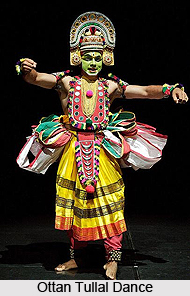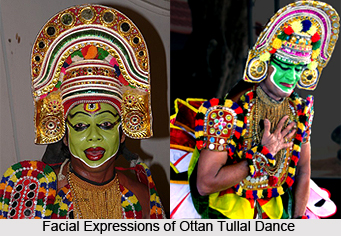 Ottan Tullal is a South Indian folk dance popular both in India and abroad. This folk dance was actually created by a poet Kunchan Nambair who lived in the 18th century. In Tullal, the performer himself sings and says the story. The troop which accompanies the main artist repeats the same when each sentence is completed.
Ottan Tullal is a South Indian folk dance popular both in India and abroad. This folk dance was actually created by a poet Kunchan Nambair who lived in the 18th century. In Tullal, the performer himself sings and says the story. The troop which accompanies the main artist repeats the same when each sentence is completed.
This dance lies somewhere in between the folk dance and classical dance. The root of this dance form has its similarity with Kathakali and follows the same principles. This form of dance had a close link with the people and it played a huge role towards their relaxation and comfort. One of the renowned faces of this art from was Malabar Raman Nair of Quilon.
Origin of Ottan Tullal Dance
According to scholars, Ottan Tullal dance was created by legendary Malayalam poet Kalakkaththu Kunchan Nambiar during 18th century. As per the story, Nambiar, who was playing the mizhavu for a Chakyar Koothu show, fell asleep while performing, thus inviting ridicule from the Chakyar. The humiliated Nambiar vowed to come up with an alternative art form to Chakyar Koothu, and conjured up an Ottamthullal show that also cracked jokes on prevalent socio political equations and prejudices of the region.
The art of Tullal was not created from the vacuum. Nambiar took some help from the existing tribal performances and gave it a great shape adding his sarcastic style of lyrics. Later, he improved it into three styles as oattan, seethankan, and parayan. The three styles were derived from the performances observed by castes like "Kanian, Pulaya and Paraya" respectively. They had minor differences in their dress and style.
 Performance of Ottan Tullal Dance
Performance of Ottan Tullal Dance
The performance of Ottan Tullal dance is quite innovative and interesting. The term Ottan Tullal means jumping and running. This dance form is always preceded by the invocation to Saraswati and Ganesha. It has various mudras, avinaya and adaus and lasts for two hours. Here the dancer usually sings the song and then acts out with lines using mimes and gestures. If the dancer wishes he may leave all the singing to his musicians.
This dance form is quite informal and the dancer goes in among the audience and interacts with all the members individually. If at any point of time, the dancer feels tired he can turn away from the audience, while the musician continues to play. The lyrics used in these songs are simpler and the costumes worn by the dancer is also quite simple. The instruments used to accompany this dance are the cymbals and the Maddalam.
Development of Ottan Tullal Dance:
Earlier, this dance was mostly performed by a single actor, donning a green make-up and wearing colourful decorative costumes and reciting the Tullal lyrics, all the while acting and dancing himself. But, it is performed as a group item as well. Women too have started practicing this art form. The performance of Ottan Tullal dance is flexible; according to situation the artist has the freedom to improvise and incorporate humour.
Present Condition of Ottan Tullal Dance:
There are not many people involved with this form of dance in the present times. The main reason that can be stated is the fact that there is not much of a financial reward involved with this dance form considering the amount of hard work that people have to put in while singing, dancing and performing.
With time the popularity of Tullal dance form has taken a serious beating and there is a serious question mark over its survival and even it is able to tide over the crisis it may not have the same popularity as it enjoyed before.



















